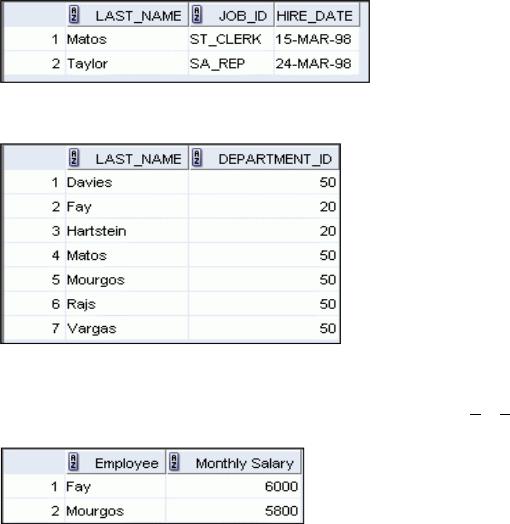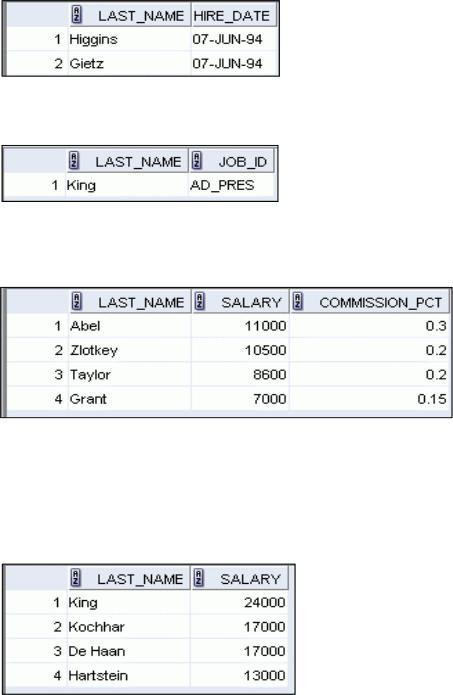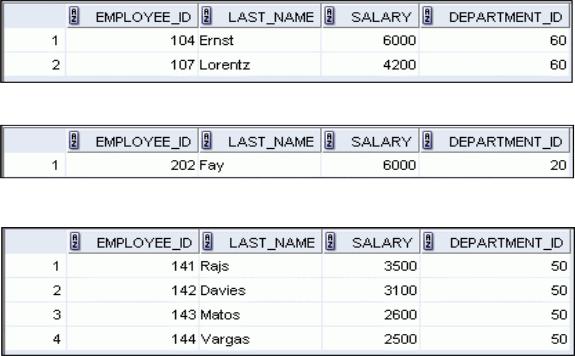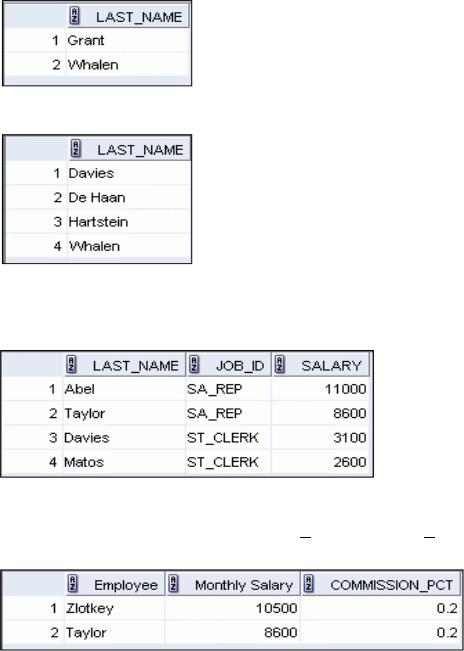
- •Preface
- •Introduction
- •Lesson Objectives
- •Lesson Agenda
- •Course Objectives
- •Course Agenda
- •Appendixes Used in the Course
- •Lesson Agenda
- •Oracle Database 11g: Focus Areas
- •Oracle Database 11g
- •Oracle Fusion Middleware
- •Oracle Enterprise Manager Grid Control 10g
- •Oracle BI Publisher
- •Lesson Agenda
- •Relational and Object Relational Database Management Systems
- •Data Storage on Different Media
- •Relational Database Concept
- •Definition of a Relational Database
- •Data Models
- •Entity Relationship Model
- •Relating Multiple Tables
- •Relational Database Terminology
- •Lesson Agenda
- •Using SQL to Query Your Database
- •SQL Statements
- •Development Environments for SQL
- •Lesson Agenda
- •The Human Resources (HR) Schema
- •Tables Used in the Course
- •Lesson Agenda
- •Oracle Database 11g Documentation
- •Additional Resources
- •Summary
- •Practice I: Overview
- •Objectives
- •Lesson Agenda
- •Capabilities of SQL SELECT Statements
- •Basic SELECT Statement
- •Selecting All Columns
- •Selecting Specific Columns
- •Writing SQL Statements
- •Column Heading Defaults
- •Lesson Agenda
- •Arithmetic Expressions
- •Using Arithmetic Operators
- •Operator Precedence
- •Defining a Null Value
- •Null Values in Arithmetic Expressions
- •Lesson Agenda
- •Defining a Column Alias
- •Using Column Aliases
- •Lesson Agenda
- •Concatenation Operator
- •Literal Character Strings
- •Using Literal Character Strings
- •Alternative Quote (q) Operator
- •Duplicate Rows
- •Lesson Agenda
- •Displaying the Table Structure
- •Using the DESCRIBE Command
- •Quiz
- •Summary
- •Practice 1: Overview
- •Objectives
- •Lesson Agenda
- •Limiting Rows Using a Selection
- •Limiting the Rows That Are Selected
- •Using the WHERE Clause
- •Character Strings and Dates
- •Comparison Operators
- •Using Comparison Operators
- •Range Conditions Using the BETWEEN Operator
- •Membership Condition Using the IN Operator
- •Pattern Matching Using the LIKE Operator
- •Combining Wildcard Characters
- •Using the NULL Conditions
- •Defining Conditions Using the Logical Operators
- •Using the AND Operator
- •Using the OR Operator
- •Using the NOT Operator
- •Lesson Agenda
- •Rules of Precedence
- •Lesson Agenda
- •Using the ORDER BY Clause
- •Sorting
- •Lesson Agenda
- •Substitution Variables
- •Using the Single-Ampersand Substitution Variable
- •Character and Date Values with Substitution Variables
- •Specifying Column Names, Expressions, and Text
- •Using the Double-Ampersand Substitution Variable
- •Lesson Agenda
- •Using the DEFINE Command
- •Using the VERIFY Command
- •Quiz
- •Summary
- •Practice 2: Overview
- •Objectives
- •Lesson Agenda
- •SQL Functions
- •Two Types of SQL Functions
- •Single-Row Functions
- •Lesson Agenda
- •Character Functions
- •Case-Conversion Functions
- •Using Case-Conversion Functions
- •Character-Manipulation Functions
- •Using the Character-Manipulation Functions
- •Lesson Agenda
- •Number Functions
- •Using the ROUND Function
- •Using the TRUNC Function
- •Using the MOD Function
- •Lesson Agenda
- •Working with Dates
- •RR Date Format
- •Using the SYSDATE Function
- •Arithmetic with Dates
- •Using Arithmetic Operators with Dates
- •Lesson Agenda
- •Date-Manipulation Functions
- •Using Date Functions
- •Using ROUND and TRUNC Functions with Dates
- •Quiz
- •Summary
- •Practice 3: Overview
- •Objectives
- •Lesson Agenda
- •Conversion Functions
- •Implicit Data Type Conversion
- •Explicit Data Type Conversion
- •Lesson Agenda
- •Using the TO_CHAR Function with Dates
- •Elements of the Date Format Model
- •Using the TO_CHAR Function with Dates
- •Using the TO_CHAR Function with Numbers
- •Using the TO_NUMBER and TO_DATE Functions
- •Using the TO_CHAR and TO_DATE Function with RR Date Format
- •Lesson Agenda
- •Nesting Functions
- •Lesson Agenda
- •General Functions
- •NVL Function
- •Using the NVL Function
- •Using the NVL2 Function
- •Using the NULLIF Function
- •Using the COALESCE Function
- •Lesson Agenda
- •Conditional Expressions
- •CASE Expression
- •Using the CASE Expression
- •DECODE Function
- •Using the DECODE Function
- •Quiz
- •Summary
- •Practice 4: Overview
- •Objectives
- •Lesson Agenda
- •What Are Group Functions?
- •Types of Group Functions
- •Group Functions: Syntax
- •Using the AVG and SUM Functions
- •Using the MIN and MAX Functions
- •Using the COUNT Function
- •Using the DISTINCT Keyword
- •Group Functions and Null Values
- •Lesson Agenda
- •Creating Groups of Data
- •Creating Groups of Data: GROUP BY Clause Syntax
- •Using the GROUP BY Clause
- •Grouping by More than One Column
- •Using the GROUP BY Clause on Multiple Columns
- •Illegal Queries Using Group Functions
- •Restricting Group Results
- •Restricting Group Results with the HAVING Clause
- •Using the HAVING Clause
- •Lesson Agenda
- •Nesting Group Functions
- •Quiz
- •Summary
- •Practice 5: Overview
- •Objectives
- •Lesson Agenda
- •Types of Joins
- •Joining Tables Using SQL:1999 Syntax
- •Qualifying Ambiguous Column Names
- •Lesson Agenda
- •Creating Natural Joins
- •Retrieving Records with Natural Joins
- •Creating Joins with the USING Clause
- •Joining Column Names
- •Retrieving Records with the USING Clause
- •Using Table Aliases with the USING Clause
- •Creating Joins with the ON Clause
- •Retrieving Records with the ON Clause
- •Creating Three-Way Joins with the ON Clause
- •Applying Additional Conditions to a Join
- •Lesson Agenda
- •Joining a Table to Itself
- •Self-Joins Using the ON Clause
- •Lesson Agenda
- •Nonequijoins
- •Retrieving Records with Nonequijoins
- •Lesson Agenda
- •INNER Versus OUTER Joins
- •LEFT OUTER JOIN
- •RIGHT OUTER JOIN
- •FULL OUTER JOIN
- •Lesson Agenda
- •Cartesian Products
- •Generating a Cartesian Product
- •Creating Cross Joins
- •Quiz
- •Summary
- •Practice 6: Overview
- •Objectives
- •Lesson Agenda
- •Using a Subquery to Solve a Problem
- •Subquery Syntax
- •Using a Subquery
- •Guidelines for Using Subqueries
- •Types of Subqueries
- •Lesson Agenda
- •Single-Row Subqueries
- •Executing Single-Row Subqueries
- •Using Group Functions in a Subquery
- •The HAVING Clause with Subqueries
- •What Is Wrong with This Statement?
- •No Rows Returned by the Inner Query
- •Lesson Agenda
- •Multiple-Row Subqueries
- •Lesson Agenda
- •Null Values in a Subquery
- •Quiz
- •Summary
- •Practice 7: Overview
- •Objectives
- •Lesson Agenda
- •Set Operators
- •Set Operator Guidelines
- •The Oracle Server and Set Operators
- •Lesson Agenda
- •Tables Used in This Lesson
- •Lesson Agenda
- •UNION Operator
- •Using the UNION Operator
- •UNION ALL Operator
- •Using the UNION ALL Operator
- •Lesson Agenda
- •INTERSECT Operator
- •Using the INTERSECT Operator
- •Lesson Agenda
- •MINUS Operator
- •Using the MINUS Operator
- •Lesson Agenda
- •Matching the SELECT Statements
- •Matching the SELECT Statement: Example
- •Lesson Agenda
- •Using the ORDER BY Clause in Set Operations
- •Quiz
- •Summary
- •Practice 8: Overview

Practice 2: Overview
This practice covers the following topics:
•Selecting data and changing the order of the rows that are displayed
•Restricting rows by using the WHERE clause
•Sorting rows by using the ORDER BY clause
•Using substitution variables to add flexibility to your SQL SELECT statements
Practice 2: Overview |
Copyright © 2009, Oracle. All rights reserved. |
Academy |
|||
|
|
|
|||
|
|
|
Oracle |
||
|
In this practice, you build more reports, including statements that use the WHERE clause and the |
||||
|
ORDER BY clause. You make the SQL statements more reusable and generic by including the |
||||
|
ampersand substitution. |
|
|
Only |
|
|
|
& |
|
||
|
Internal |
|
|
|
|
Oracle |
Use |
|
|||
|
|
|
|
||
Oracle Database 11g: SQL Fundamentals I 2 - 39

Practice 2
The HR department needs your assistance in creating some queries.
1. Because of budget issues, the HR department needs a report that displays the last name and salary of employees who earn more than $12,000. Save your SQL statement as a file named lab_02_01.sql. Run your query.
2. Open a new SQL Worksheet. Create a report that displays the last name and department number for employee number 176. Run the query.
3. The HR department needs to find high-salary and low-salary employees. Modify
lab_02_01.sql to display the last name and salary for any employee whose salary is not in |
|
|
Academy |
the range of $5,000 to $12,000. Save your SQL statement as lab 02 03.sql. |
|
Oracle |
|
& |
Only |
Internal |
|
Use |
|
Oracle |
|
Oracle Database 11g: SQL Fundamentals I 2 - 40

Practice 2 (continued)
4.Create a report to display the last name, job ID, and hire date for employees with the last names of Matos and Taylor. Order the query in ascending order by the hire date.
5.Display the last name and department ID of all employees in departments 20 or 50 in ascending alphabetical order by name.
|
|
Academy |
6. Modify lab_02_03.sql to display the last name and salary of employees who earn between |
||
$5,000 and $12,000, and are in department 20 or 50. Label the columns Employee and |
||
Monthly Salary, respectively. Resave lab_02_03.sql as lab 02 06.sql. Run the |
||
statement in lab_02_06.sql. |
|
|
|
Oracle |
|
|
& |
Only |
Internal |
|
|
Oracle |
Use |
|
|
|
|
Oracle Database 11g: SQL Fundamentals I 2 - 41

Practice 2 (continued)
7. The HR department needs a report that displays the last name and hire date for all employees who were hired in 1994.
8. Create a report to display the last name and job title of all employees who do not have a manager.
9. Create a report to display the last name, salary, and commission of all employees who earn commissions. Sort data in descending order of salary and commissions.
Use the column’s numeric position in the ORDER BY clause.
10. Members of the HR department want to have more flexibility withAcademythe queries that you are more than an amount that the user specifies after a prompt. Save this query to a file named
writing. They would like a report that displays the last name and salary of employees who earn
|
Oracle |
|
lab_02_10.sql. If you enter 12000 when prompted, the r port displays the following |
||
results: |
|
Only |
|
& |
|
Internal |
|
|
|
Use |
|
Oracle |
|
|
Oracle Database 11g: SQL Fundamentals I 2 - 42

Practice 2 (continued)
11.The HR department wants to run reports based on a manager. Create a query that prompts the user for a manager ID and generates the employee ID, last name, salary, and department for that manager’s employees. The HR department wants the ability to sort the report on a selected column. You can test the data with the following values:
manager_id = 103, sorted by last_name:
manager_id = 201, sorted by salary:
manager_id = 124, sorted by employee_id:
|
Academy |
Oracle |
|
& |
Only |
Internal |
|
Use |
|
Oracle |
|
Oracle Database 11g: SQL Fundamentals I 2 - 43

Practice 2 (continued)
If you have time, complete the following exercises:
12.Display all employee last names in which the third letter of the name is “a.”
13.Display the last names of all employees who have both an “a” and an “e” in their last name.
If you want an extra challenge, complete the following exercises:
14. Display the last name, job, and salary for all employees whose jobs are either those of a sales representative or of a stock clerk, and whose salaries are not equal to $2,500, $3,500, or $7,000.
|
|
Academy |
|
Oracle |
|
15. Modify lab_02_06.sql to display the last name, salary, and commission for all employees |
||
whose commission is 20%. Resave lab_02 06.sql as lab 02_15.sql. Rerun the |
||
statement in lab_02_15.sql. |
|
Only |
|
& |
|
Internal |
|
|
Use |
||
Oracle |
|
|
Oracle Database 11g: SQL Fundamentals I 2 - 44

Using Single-Row Functions to
Customize Output
|
Copyright © 2009, Oracle. All rights reserved. |
Academy |
||
|
|
|||
|
|
Oracle |
||
& |
Only |
|
||
|
Internal |
|
|
|
|
Use |
|
||
Oracle |
|
|
|
|
